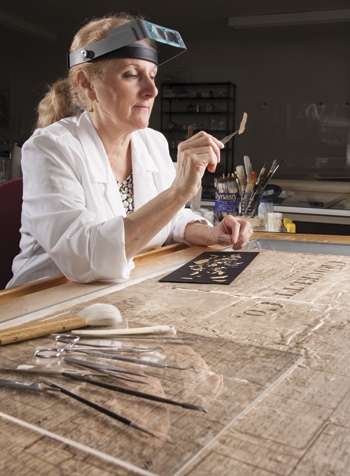Cheryl Carrabba gently fingers the tattered bits of paper flaking off an 1886 Reeves and Pecos counties railroad survey blueprint. When she first unrolled the blueprint on a worktable, map pieces held precariously in place by adhesive tape and raw silk fell away, like dead leaves dropping from a drought-stricken tree.
As chief conservator for the Texas General Land Office’s historic document preservation program, Carrabba is used to puzzling over such perplexing situations. Every three to four months, she drives from her North Austin business, Carrabba Conservation, to the GLO near the Capitol, dropping off completed work orders and picking up new batches of maps and related documents in need of professional, emergency repair.
Carrabba sees the results of well-intentioned efforts to save maps long before modern conservation techniques were the norm. Adhesive tape can leave permanent stains. And raw silk, essentially pasted-down netting holding pieces in place, ultimately does more harm than good.
Sometimes, map pieces attached to linen backing simply fall off. Occasionally, per the diligence of GLO officials trying to preserve a document’s integrity, Carrabba receives broken-off pieces in separate envelopes.
It is then Carrabba’s job to put the pieces back together. In some cases, she can rebuild an entire section of a county. But this is conservation work, not restoration: What’s gone is gone. On an April afternoon, Carrabba inspects a 1901 Dallam County map she’s been working on, a hand-drawn manuscript that’s clean and pretty … with some information missing.
“I wish I had it, but I don’t,” Carrabba says. “If I did, I’d put it in.”
The pieces are lost, forever. And therein lies the mission of the GLO’s Save Texas History program: Conserve and protect the land office’s historic and invaluable documents, the oldest dating back to 1720, for future generations. On disintegrating maps, save what information remains—including details hanging by a thread.
But conservation can’t be rushed. It typically takes Carrabba three months to complete an average-size work order of 17 maps, a fastidious, laborious process of cleaning, mending and relining paper documents with handmade, acid-free Japanese tissues and papers. It also takes money. With fragile documents at risk, including those bearing the original signatures of such Texas heroes as Jim Bowie and Stephen F. Austin, GLO officials are asking Texans to “adopt” a state map or document by paying its conservation fee.
Adoptions take on critical importance: The land office contains records of every original, handwritten survey representing almost every square inch of land in Texas. Accordingly, the GLO’s working archive is accessed daily by surveyors and title and genealogical researchers.
Yet some files are finally getting a break: Since 2000, more than 2.5 million of the land office’s 35.5 million archival documents, including all maps, have been digitally scanned in full color and are available for online use. “You have the opportunity now to search 24/7,” says Susan Smith Dorsey, director and records management officer of the GLO’s archives and records program. “If you want to get up in the middle of the night and search in your pajamas, you can.”
Meanwhile, the GLO’s original documents are resting inside a repository opened in 2005 featuring state-of-the-art climate-control and fire-suppression systems. Maps are laid flat inside cabinets, safe in a dark, sterile environment.
But not even a world-class storage system can resuscitate documents damaged long ago: Carrabba gets old maps that have been ripped, rolled, stacked, glued, taped, varnished, chewed by bugs, exposed to light and heat, attacked by mold, and folded and unfolded countless times.
She heeds the conservator’s creed: Do no harm. And just like the medical profession from whence that motto comes, Carrabba, whose background includes work as a registered nurse, focuses on saving the lives of her patients—vulnerable, stressed documents—in need of tender, loving care.
Context comes before beauty. Carrabba holds up a conserved 1881 Tyler County map that came to her horribly scarred by mold. Wetting the linen backing would have caused more damage, and using a cotton swab for cleaning could have obliterated a river. So the brown scars remain—and the map is saved.
Carrabba, who earned certification in paper conservation from London’s highly acclaimed Camberwell College of Arts in 1978, is part doctor, part artist, part seamstress and part chemist who cooks her own adhesive—preservative-free wheat starch paste.
All projects begin with photo documentation: the recording of a document’s condition before original backings are removed by washing maps in warm, filtered water. Next, old adhesives are removed with soft brushes, cotton balls and cotton swabs; blotter washes absorb and draw off dirt and debris.
The mending process includes a mattress needle and a thin Japanese tissue called tengujo, made from kozo plant fibers. Once mended, documents are slowly dried—laid flat and pulled taut—for two to three days. Next, maps receive new Japanese paper backings: first, kitakata, made from fibers of the gampi bush; followed by okawara, made from kozo fibers. Finally, maps are trimmed, sealed and placed in Mylar sleeves.
Carrabba marvels at the resiliency of paper documents, but it’s not enough for them to merely survive. As the recorded history of a vast industrial culture, they must be preserved. Otherwise, as Carrabba says, “like cave paintings and relics from thousands of years ago, they will recede with the advances of our electronic age.”
So goes the work of the paper conservator, painstakingly reversing the ravages of time, map by map, thread by thread.
——————–
Camille Wheeler is an Austin writer.


